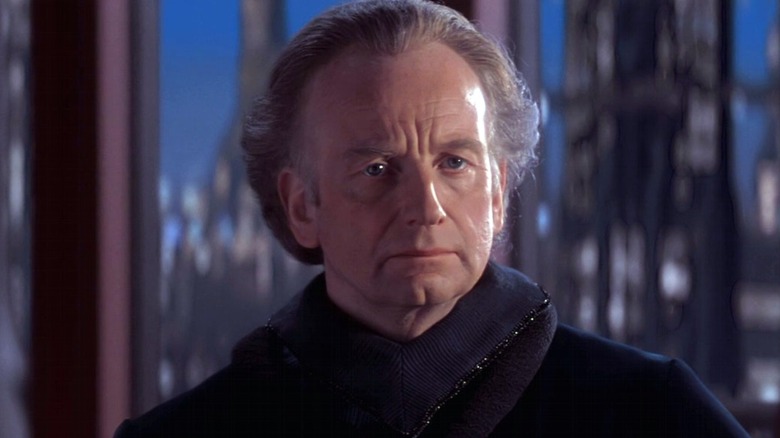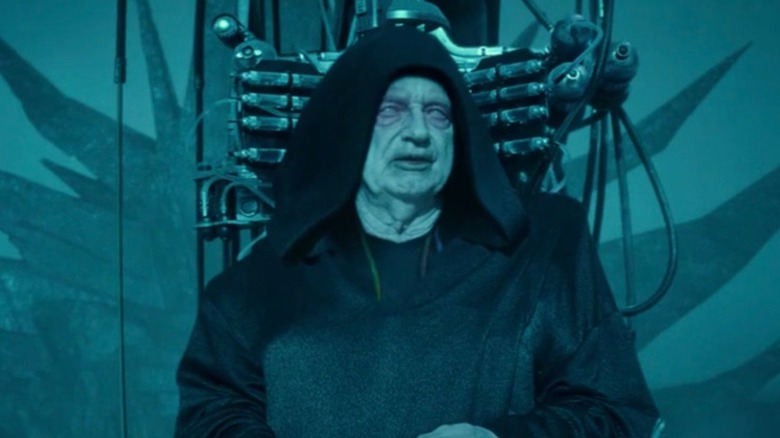Star Wars: Who Is Darth Plagueis? Palpatine's Sith Master Explained
In one of the most iconic scenes of "Star Wars: Episode III – Revenge of the Sith," Chancellor Sheev Palpatine (Ian McDiarmid) takes Anakin Skywalker (Hayden Christiansen) to the opera. There, he tells him the tragedy of Darth Plagueis the Wise, convincing him that the only way to save his love, Padme Amidala (Natalie Portman), is through abilities known only to the Sith. Anakin takes the tale to heart, and he eventually turns to the dark side, but who is this Plagueis person whose story holds so much significance? Here's what's most important to know about one of the most powerful Sith in the "Star Wars" Universe.
Before the events of the Skywalker saga, Plagueis takes on Palpatine as his Sith apprentice, and they get to work trying to achieve immortality and ultimate power. Though they fail to form a Force dyad with one another, which would've pooled their power through the Force itself, they do find luck with midi-chlorian manipulation and the creation of life. Plagueis also takes a vested interest in the transference Force ability, which is when a Force user transfers their consciousness from one body to another. During his studies, Plagueis positions Palpatine within the Galactic Senate and aims for him to climb the ladder so that the Sith may topple the Galactic Republic, thus paving the way for a new Sith Empire.
In the end, Palpatine does what Sith do best: betray their masters. He kills Plagueis in his sleep, takes on various apprentices of his own, and becomes the Emperor of his own Sith regime. Despite killing him, Palpatine never lets go of Plagueis' influence. In fact, he embraces it in more ways than one.
Plagueis' influence never leaves Palpatine
Even with Darth Plagueis dead and gone, Sheev Palpatine remains committed to his master's political cause. He tactfully overthrows the Galactic Republic and becomes the Emperor of the reorganized Galactic Empire, ruling with an iron fist. When he loses and the Empire falls at the end of the Galactic Civil War, he hides in the shadows for decades before reemerging with effectively the same plan. With countless troops and ships at his disposal, he attempts to sidestep the Resistance and First Order conflict to make the Sith Eternal the dominant faction in the galaxy.
Throughout all of this, Palpatine maintains the Sith studies he began with Plagueis and continues their pursuit of immortality. He spends much of the Empire's reign exploring cloning, though, as seen with projects like the clone body he occupies on Exegol in "Star Wars: Episode IX – The Rise of Skywalker," he doesn't quite nail it. Seeing as he moves his mind from one body to another, it's fair to say he at least figures out Force transference. He also creates artificial beings like Supreme Leader Snoke (Andy Serkis) along the way, and uses Rey (Daisy Ridley) and Ben Solo's (Adam Driver) Force dyad to regenerate himself.
All in all, Darth Plagueis is a victim of his own ambition. He wants power, eternal life, and Sith glory so badly that it never even occurs to him that he's outlasted his usefulness to his apprentice. At the same time, his knowledge, techniques, and goals very much live on through Emperor Palpatine. In a sense, he achieves the enduring life he so strongly desires. He's just not alive to see it.

